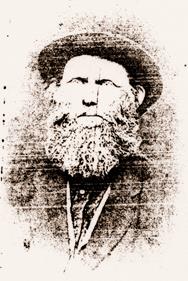52 Ancestors in 52 Weeks no. 15—Caleb Reed (1818-1903)
A large extended family of Reeds began with the birth of a baby boy near a small Kentucky stream on 1 December 1818. At a farm along a waterway called Elk Creek southeast of Louisville, Kentucky, Caleb Reed came into the world that day. 
The Elk Creek area was part of Shelby County at the time, but the state later split off lands from Shelby, Nelson, and Bullitt Counties to form the new Spencer County a few years later in 1824. Thus, we find Reed records in two Kentucky jurisdictions even though the family did not move.
At the time of their son’s birth, parents Thomas Reed and Ann Kirkham Reed already had three other children, Robertson (b. 1808), Eliza (b. 1810), and Jane (b. 1817). The family later added another brother, William (b. 1822).
Baby Caleb became one of many family members to share the same name. His paternal grandfather was also named Caleb Reed. That Caleb had a son Caleb C. Reed (our Caleb’s uncle). Our Caleb later had a nephew, Caleb R., son of his brother Robertson. Subsequent generations would continue to use the name. Our Caleb would have two grandsons who shared his name: Caleb Logan Reed and Caleb Reed Wright.
Some uncertainty surrounds Caleb’s full name. The family Bible simply gives his name as Caleb with no middle name. His marriage record lists his name as Caleb Samuel Reed. A different name appeared in his obituary where the informant reported his name as Joseph Caleb. Neither of these full names is corroborated by any other source.
Caleb lived his first decade in Kentucky until his parents decided in 1829 to move to lands newly-opened for settlement in Illinois. On his eleventh birthday the family left the state of Kentucky to find a new home in the wilderness. The journey consumed nearly a month.
Arriving in Edgar County, Illinois, they spent a few days. About New Year 1830, they went westward on to Coles County. They settled about one and a half miles from of the village of Ashmore. Caleb Reed later owned that farm.
At some time during his life, Caleb learned to read and write. If he attended school in Illinois, perhaps he went to the first school in Ashmore, located at the southwest edge of town. It was a fair weather school made of logs and had an earthen floor. The three sided structure opened to the south with a split log shelf along the two sides. The seats were crude split logs with pegged legs. The building also served as a church.
When Caleb was 25 years old, he married a neighbor girl, Jane Carter, daughter of John Carter and Mary (Polly) Templeton Carter. Caleb and Jane wed on 22 February 1844 at Coles County, Illinois where they were united by a Justice of the Peace. They eventually had eleven children: Samuel (1845-1928), Mary (1847-1855), Martha (1849-1918), George (1851-1886), Thomas B. (1853-1854), Emma Jane (1855-1888), John (1857-1921), Thomas L. (1860-1925), James (1862-1864), Ida May (1864-1954), and Albert (1866-1890).
Even before Caleb married Jane, he began accumulating land holdings. At the age of twenty-two he went to the federal land office at Palestine, Illinois on 20 May 1841 and bought the SESE/4 of Section 6, T12 N, R14W, Coles County, Illinois. He received an adjacent 177 acres of land in Section 6 from his father in 1847. On 1 February 1850 he bought the NESE/4 of the same section. At the time of the 1850 United States census, their nearest post office was in Hitesville, a town about 2 miles southeast of Ashmore. It no longer exists.
Caleb’s younger brother William died in 1845, and his death left four surviving Reed siblings. When their father Thomas passed away a few years later in 1852, Caleb inherited a 1/4 share of the family farm. He and his brother Rob then purchased their sisters’ shares. Caleb settled in to life as a farmer and stock raiser. He never sought official positions because he felt his farm of 430 acres required his entire attention. He and Jane lived on the site of his father’s original settlement.
By 1860, Caleb owned $1200 worth of livestock. He was a farmer with $6000 in real estate and $1000 in personal property. Today the farmland alone is worth over $3 million, and Caleb’s descendants still own it. In May and October 1864, when an income tax was briefly enacted to fund the Civil War, Caleb paid tax of $9 and $15 to the assessor.
The Masons organized in Coles County during the Civil War in 1863. Caleb Reed together with Jane’s brother-in-law Robert Boyd (her sister Nancy’s husband) became charter members of Ashmore Lodge, No. 390. Caleb was elected Junior Warden, and Boyd served as tiler or guardian to the entrance of the Lodge.
Coles County furnished more than its quota of soldiers for the Union Army during the war years, but most volunteers were from the western part of the county. On the eastern side, where the Reeds and Carters lived, there were many rebel sympathizers who had come from Kentucky. These people hated abolitionists and the draft. Although Caleb Reed did register for the draft as required in June 1863, there is no record of his eligible son Samuel registering or serving from Coles County.
 As the war progressed, troops constantly moved through the Ashmore area. Local farmers supplied corn at the high war price of $.60 per bushel. Perhaps Caleb was able to add to his wealth by selling farm products to the Army.
As the war progressed, troops constantly moved through the Ashmore area. Local farmers supplied corn at the high war price of $.60 per bushel. Perhaps Caleb was able to add to his wealth by selling farm products to the Army.
In March 1864, Caleb and Jane must have watched with interest as tensions between Union soldiers and local insurgents known as Copperheads heightened in Coles County. On March 28, 1864, violence erupted when the former sheriff of Coles County and the Copperheads attacked a group of soldiers in Charleston, the county seat 10 miles from the Reed farm. In the end, 9 people died, 12 were wounded, and 29 men were arrested in what became known as the Charleston Riot. Among those apprehended was John Galbreath, a relative of Caleb’s sister Jane Reed Galbreath.
After the war, Caleb and Jane continued living on their farm. In 1878, Caleb was appointed by the Coles County Board of Supervisors to serve as a Grand juryman from Ashmore Township for the November term.
At some point, the Reeds decided to retire from the farm and move into Ashmore. They lived in one house for a while and then traded houses with their friend Newt Austin for a home located mid-block west of the Presbyterian Church. Newt was related to Jane’s sister Susan Carter Austin.
The Reed’s grandchildren visited often, and Jane would send them to the butcher shop to buy for the noon dinner. Some of the grandchildren complained about having to visit because they found nothing to do there. The only entertainment was to watch the trains come into town. The only reading material was the Sunday School newsletter.
By 1902, Caleb’s health was beginning to fail. He sold some of his land to his sons T. L. Reed and John C. Reed. The following year, he sold land in Section 7, Twp. 12 North, Range 14 West to his daughter Ida May Thompson for $1.00.
In the spring of 1903, the Mattoon, Illinois newspaper reported that Caleb Reed had taken quite sick on the previous Saturday, May 16, and remained in feeble condition. The following week he was no better. Ida Thompson visited her parents and then returned home to Indiana. Later that summer, she was again at the bedside of her aged father who was in very poor health.
On 10 November 1903 at his home in Ashmore, Caleb ate a hearty breakfast. He felt as well as usual but continued to be ill with kidney trouble. After his meal he went to take his customary rest while Jane was in another room attending to her household duties. Thinking that he had slept long enough she went to rouse him and found that he had passed away at the age of eighty-four.
Two days later on the day of Caleb’s funeral, the family sat at the house in an uncomfortable hush until it was time to go to Ashmore Cemetery. A few, including his widow, went by carriage, but the others walked behind the men carrying the casket. As one bearer tired, another stepped up to take his place. There was a graveside prayer.
Caleb left behind a large family clan that became known to later generations as the Reeds of Ashmore. Although he had outlived six of his eleven children, he had numerous descendants in Ashmore and beyond.
